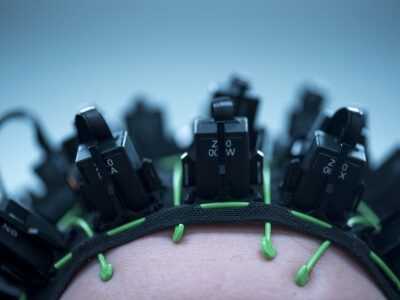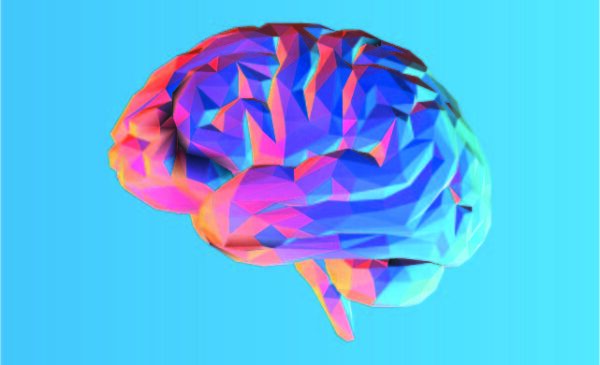A new type of wearable brain scanner is a step closer to being used in hospitals with the launch of a new spin-out company formed by UK Quantum Technology Hub Sensors and Timing researchers at the University of Nottingham and Magnetic Shields Ltd (MSL).
Cerca Magnetics Limited aims to bring the world’s most advanced brain scanner to market. The Cerca Scanner has been specially designed to allow people to move freely whilst being scanned, and will offer an unprecedented window on brain function and give new hope to people suffering with severe neurological illnesses, such as epilepsy.
Hub researchers at the University of Nottingham have been developing the technology for the wearable brain scanner for the past five years in collaboration with neuroscientists at University College London. Their research, funded by the UK Quantum Technologies Programme, Innovate UK, and the Wellcome Trust, has demonstrated the ability to create images of the brain with millimetre accuracy, even when the person being scanned is moving. This opens up new possibilities for imaging babies and children.
This new wearable scanner is based on a technique called magnetoencephalography (MEG), in which the tiny magnetic fields generated by electrical current flow in brain cells are measured. Mathematical reconstruction of those fields generates images showing moment-to-moment changes in brain activity. These unique pictures can tell us how our brains respond when we perform a mental task, and more importantly, how things begin to go wrong in neurological or mental health problems.
Whilst other MEG scanners exist, the Cerca System is unique since it is the only “wearable” MEG system allowing patients to move freely during the scan. It also uniquely adapts to different head sizes, making it possible to scan adults, or babies, using the same system. It offers considerably higher sensitivity and spatial specificity compared to the best existing systems and all of this can be achieved at lower cost.
Dr Elena Boto, University of Nottingham scientist and chief technology officer for Cerca, said: “5 years ago, we started with a few equations on the back of an envelope, and a few lines of computer code to simulate a system. To have seen this mature into a commercialisable imaging system, which can outperform anything available currently, has been remarkable. There are many advantages to our system but for me the biggest is the ability to scan babies and children. Neurological disorders, like epilepsy, often strike in young children and this new system will provide new information to medical professionals which they can use in treatment planning.”
The perfect partnership
As the magnetic fields from the brain are so small, the scanner needs to sit in a well-controlled magnetic field environment. MSL are the world leaders in magnetic shielding and had already been working with University of Nottingham scientists to develop magnetically-shielded enclosures into which the scanner (and other magnetically-sensitive devices) can be installed. The new partnership now takes this one step further, with Cerca selling the complete integrated brain imaging system.
David Woolger, CEO of Cerca said: “The commercial opportunity is extremely exciting. The system that has been developed in Nottingham is remarkable, but its real impact will only be realised if the technology can be spread around the world. Cerca are already working with some of the world’s best research laboratories to deliver our first generation of system for deployment in the field. We hope and believe that within 3-5 years, we can see the technology becoming commonplace in hospitals”.

Quantum technology
Conventional MEG scanners are based on magnetic field detectors that must be cooled to -269 degrees in order to operate. Consequently they are extremely large and cumbersome; the need for thermal insulation means it is hard to get ‘supercooled’ sensors close to the head (reducing sensitivity and spatial accuracy), and because the sensors must be static, the system cannot adapt to different head shapes and sizes and patients must remain still for very long periods. These systems are also extremely expensive. The new system is based upon recently developed “quantum” sensors, which use the fundamental properties of atoms to sense local magnetic fields. These new sensors, called optically-pumped magnetometers or OPMs, do not require cryogenic cooling. They are also extremely small and lightweight (similar in size to a Lego brick). This means they can be mounted in a helmet which the patient wears. The helmet can adapt to any head shape or size, and because it is lightweight and moves with the head, it is completely insensitive to motion. In addition, because no thermally insulating gap between scalp and sensor is required, the sensors get closer to the head and therefore capture a higher amplitude signal, consequently gaining better data.
Professor Matt Brookes, who leads MEG research in Nottingham, said: “The combination of quantum technology and novel magnetic shielding has offered something completely unique – a wearable brain scanner that lifts the restrictions surrounding conventional imaging systems of this type. The Cerca System will provide an extremely advanced device for neuroscientific experimentation. More importantly it will enable a new way to investigate myriad brain health conditions. Understanding the human brain and the many severe and debilitating conditions that affect it is one of the biggest challenges for 21st century science. This new technology will provide one of the platforms from which scientists and clinicians can begin to meet that challenge.”
The underlying research was funded by the Engineering and Physical Sciences Research Council through the UK Quantum Technology Hub Sensors and Timing, part of the £1bn UK National Quantum Technologies Programme. Funding and support for the creation of Cerca has also been provided by Nottingham Technology Ventures, and the research has also been funded by Innovate UK and by a Wellcome Trust Collaboration in Science grant awarded jointly to the University of Nottingham and partners at University College London.
Ends
More information is available from Professor Matthew Brookes at the University of Nottingham [email protected] or Eliot Dawson on [email protected] or Jane Icke, Media Relations Manager for the Faculty of Science at the University of Nottingham, on +44 (0)115 951 5751, [email protected]
Notes to editors
The University of Nottingham is a research-intensive university with a proud heritage, consistently ranked among the world’s top 100. Studying at the University of Nottingham is a life-changing experience and we pride ourselves on unlocking the potential of our students. We have a pioneering spirit, expressed in the vision of our founder Sir Jesse Boot, which has seen us lead the way in establishing campuses in China and Malaysia – part of a globally connected network of education, research and industrial engagement. The University’s state-of-the-art facilities and inclusive and disability sport provision is reflected in its status as The Times and Sunday Times Good University Guide 2021 Sports University of the Year. We are ranked eighth for research power in the UK according to REF 2014. We have six beacons of research excellence helping to transform lives and change the world; we are also a major employer and industry partner – locally and globally. Alongside Nottingham Trent University, we lead the Universities for Nottingham initiative, a pioneering collaboration which brings together the combined strength and civic missions of Nottingham’s two world-class universities and is working with local communities and partners to aid recovery and renewal following the COVID-19 pandemic.
About Cerca Magnetics Limited:
Cerca Magnetics Limited is a joint venture between Magnetic Shields Limited and The University of Nottingham.
Cerca’s team brings together experienced business leadership with world-leading scientists, facilitating the commercialisation of UoN’s and MSL’s pioneering research and intellectual property related to the use of OPM sensors for biomagnetic imaging.
Cerca OPM-MEG Scanner:
Our device measures the very small magnetic fields generated by neuronal currents in the brain, a process known as magnetoencephalography (MEG). In this way, we can provide direct inference on the electrical activity of neurons. Exploiting new breakthroughs in quantum physics to use sensors known as optically-pumped magnetometers (OPMs), we have developed and bought to market the world’s first commercial, fully integrated brain imaging device based on OPMs, known as an OPM-MEG scanner.
About the UK Quantum Technology Hub Sensors and Timing:
The UK Quantum Technology Hub Sensors and Timing (led by the University of Birmingham) brings together experts from Physics and Engineering from the Universities of Birmingham, Glasgow, Imperial, Nottingham, Southampton, Strathclyde and Sussex, NPL, the British Geological Survey and over 70 industry partners. The Hub has over 100 projects, valued at approximately £100 million, and has 17 patent applications.
The UK Quantum Technology Hub Sensors and Timing is part of the National Quantum Technologies Programme (NQTP), which was established in 2014 and has EPSRC, IUK, STFC, MOD, NPL, BEIS, and GCHQ as partners. Four Quantum Technology Hubs were set up at the outset, each focussing on specific application areas with anticipated societal and economic impact. The Commercialising Quantum Technologies Challenge (funded by the Industrial Strategy Challenge Fund) is part of the NQTP and was launched to accelerate the development of quantum enabled products and services, removing barriers to productivity and competitiveness. The NQTP is set to invest £1B of public and private sector funds over its ten-year lifetime.




